Marketing Consumer Behaviour: TPB, Innovation & McDonald's Strategy
VerifiedAdded on 2023/06/12
|15
|4291
|247
Essay
AI Summary
This essay delves into consumer behavior through two primary lenses: the Theory of Planned Behavior (TPB) and the Diffusion of Innovation theory, further applying these concepts to a McDonald's marketing strategy. The first section elucidates the core tenets of TPB, including attitudes, behavioral intention, subjective norms, social norms, perceived power, and perceived behavioral control, while also considering the theory's advantages and disadvantages. It then connects TPB with the Diffusion of Innovation theory, highlighting how innovation influences consumer decision-making, using Apple Inc. as a prime example. The second part of the essay shifts focus to McDonald's potential use of organic food as a marketing strategy, exploring the relevance of trait theory in understanding consumer preferences for organic options and how McDonald's can leverage this for marketing purposes. The essay concludes by emphasizing the practical application of consumer behavior theories in real-world business scenarios.
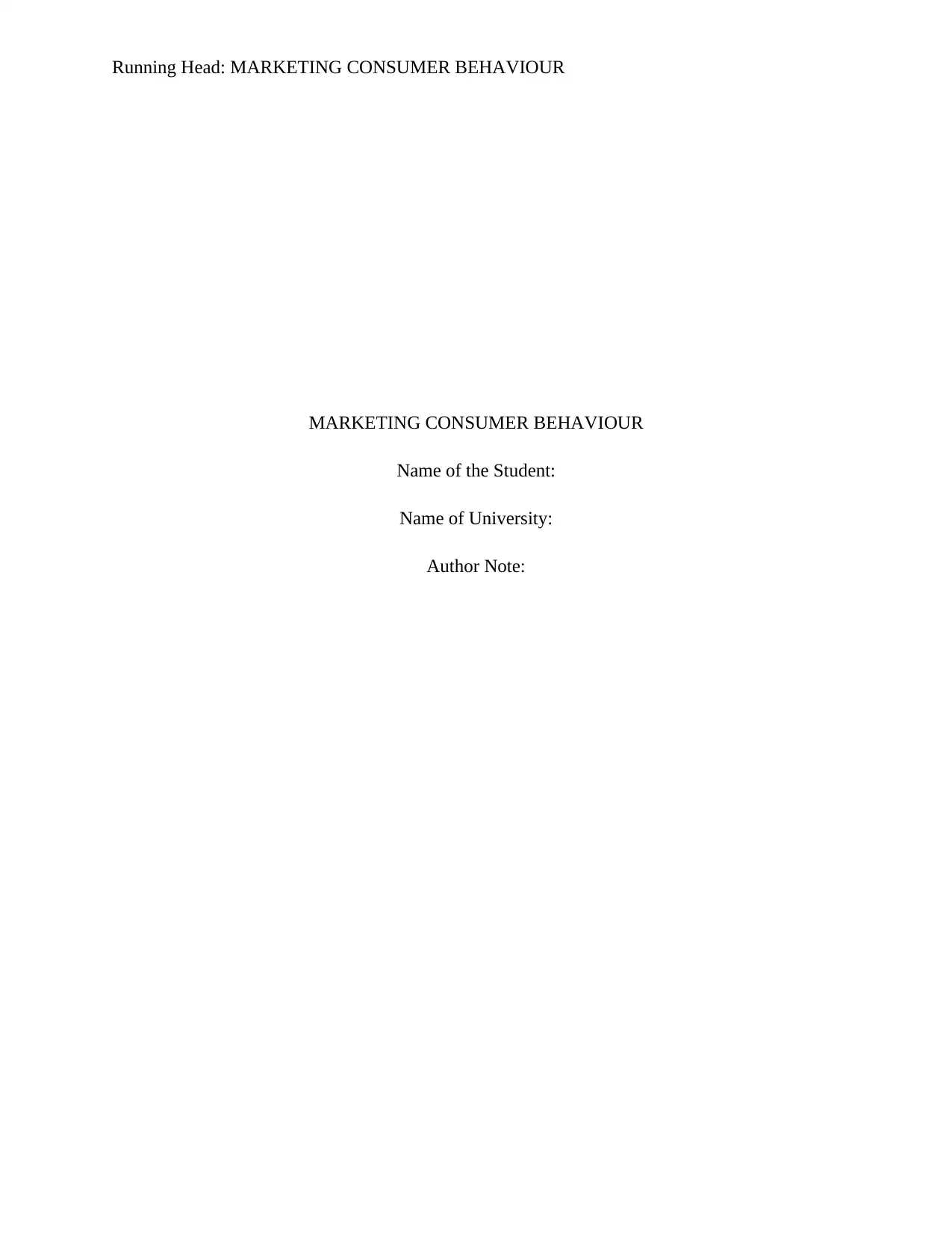
Running Head: MARKETING CONSUMER BEHAVIOUR
MARKETING CONSUMER BEHAVIOUR
Name of the Student:
Name of University:
Author Note:
MARKETING CONSUMER BEHAVIOUR
Name of the Student:
Name of University:
Author Note:
Paraphrase This Document
Need a fresh take? Get an instant paraphrase of this document with our AI Paraphraser
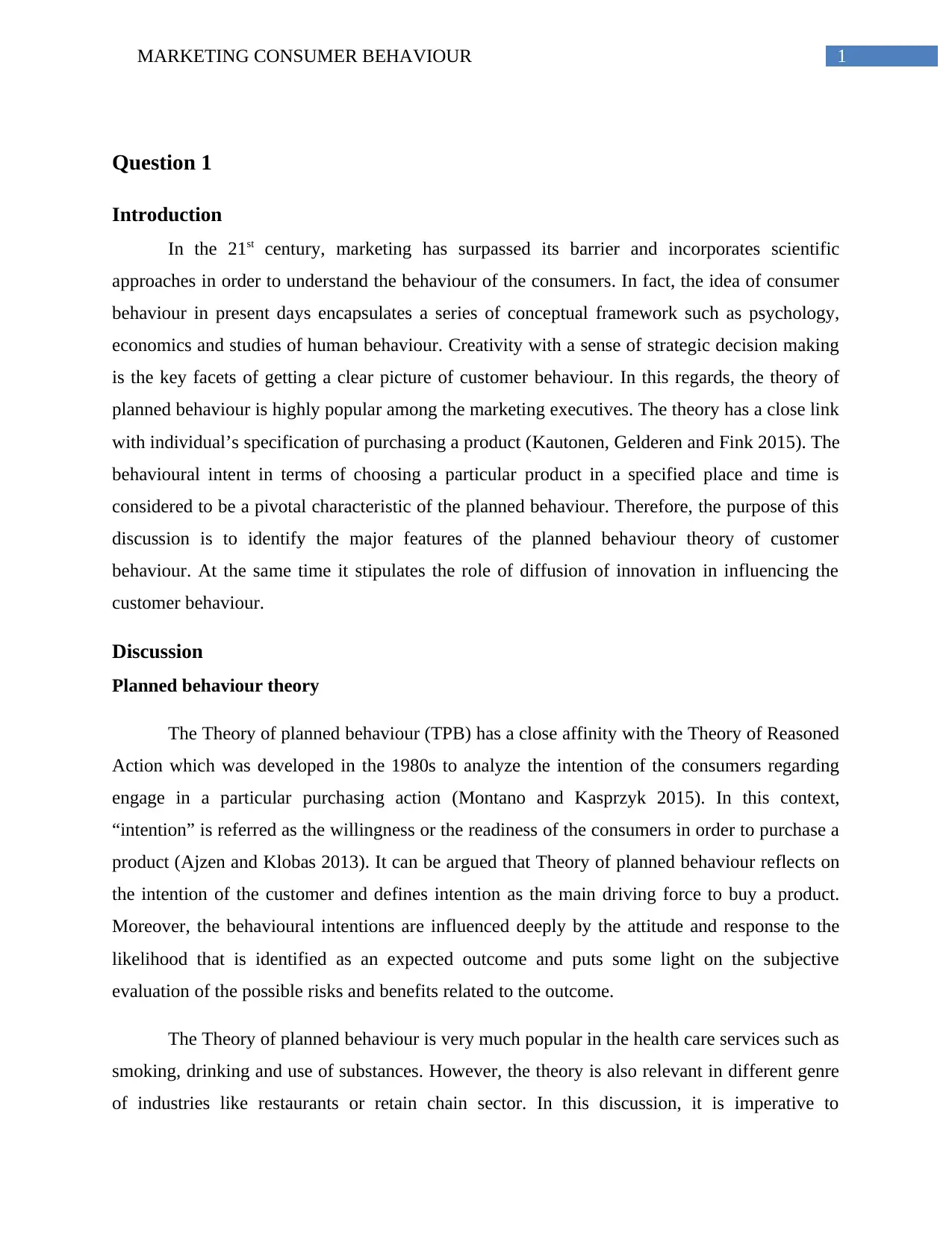
1MARKETING CONSUMER BEHAVIOUR
Question 1
Introduction
In the 21st century, marketing has surpassed its barrier and incorporates scientific
approaches in order to understand the behaviour of the consumers. In fact, the idea of consumer
behaviour in present days encapsulates a series of conceptual framework such as psychology,
economics and studies of human behaviour. Creativity with a sense of strategic decision making
is the key facets of getting a clear picture of customer behaviour. In this regards, the theory of
planned behaviour is highly popular among the marketing executives. The theory has a close link
with individual’s specification of purchasing a product (Kautonen, Gelderen and Fink 2015). The
behavioural intent in terms of choosing a particular product in a specified place and time is
considered to be a pivotal characteristic of the planned behaviour. Therefore, the purpose of this
discussion is to identify the major features of the planned behaviour theory of customer
behaviour. At the same time it stipulates the role of diffusion of innovation in influencing the
customer behaviour.
Discussion
Planned behaviour theory
The Theory of planned behaviour (TPB) has a close affinity with the Theory of Reasoned
Action which was developed in the 1980s to analyze the intention of the consumers regarding
engage in a particular purchasing action (Montano and Kasprzyk 2015). In this context,
“intention” is referred as the willingness or the readiness of the consumers in order to purchase a
product (Ajzen and Klobas 2013). It can be argued that Theory of planned behaviour reflects on
the intention of the customer and defines intention as the main driving force to buy a product.
Moreover, the behavioural intentions are influenced deeply by the attitude and response to the
likelihood that is identified as an expected outcome and puts some light on the subjective
evaluation of the possible risks and benefits related to the outcome.
The Theory of planned behaviour is very much popular in the health care services such as
smoking, drinking and use of substances. However, the theory is also relevant in different genre
of industries like restaurants or retain chain sector. In this discussion, it is imperative to
Question 1
Introduction
In the 21st century, marketing has surpassed its barrier and incorporates scientific
approaches in order to understand the behaviour of the consumers. In fact, the idea of consumer
behaviour in present days encapsulates a series of conceptual framework such as psychology,
economics and studies of human behaviour. Creativity with a sense of strategic decision making
is the key facets of getting a clear picture of customer behaviour. In this regards, the theory of
planned behaviour is highly popular among the marketing executives. The theory has a close link
with individual’s specification of purchasing a product (Kautonen, Gelderen and Fink 2015). The
behavioural intent in terms of choosing a particular product in a specified place and time is
considered to be a pivotal characteristic of the planned behaviour. Therefore, the purpose of this
discussion is to identify the major features of the planned behaviour theory of customer
behaviour. At the same time it stipulates the role of diffusion of innovation in influencing the
customer behaviour.
Discussion
Planned behaviour theory
The Theory of planned behaviour (TPB) has a close affinity with the Theory of Reasoned
Action which was developed in the 1980s to analyze the intention of the consumers regarding
engage in a particular purchasing action (Montano and Kasprzyk 2015). In this context,
“intention” is referred as the willingness or the readiness of the consumers in order to purchase a
product (Ajzen and Klobas 2013). It can be argued that Theory of planned behaviour reflects on
the intention of the customer and defines intention as the main driving force to buy a product.
Moreover, the behavioural intentions are influenced deeply by the attitude and response to the
likelihood that is identified as an expected outcome and puts some light on the subjective
evaluation of the possible risks and benefits related to the outcome.
The Theory of planned behaviour is very much popular in the health care services such as
smoking, drinking and use of substances. However, the theory is also relevant in different genre
of industries like restaurants or retain chain sector. In this discussion, it is imperative to
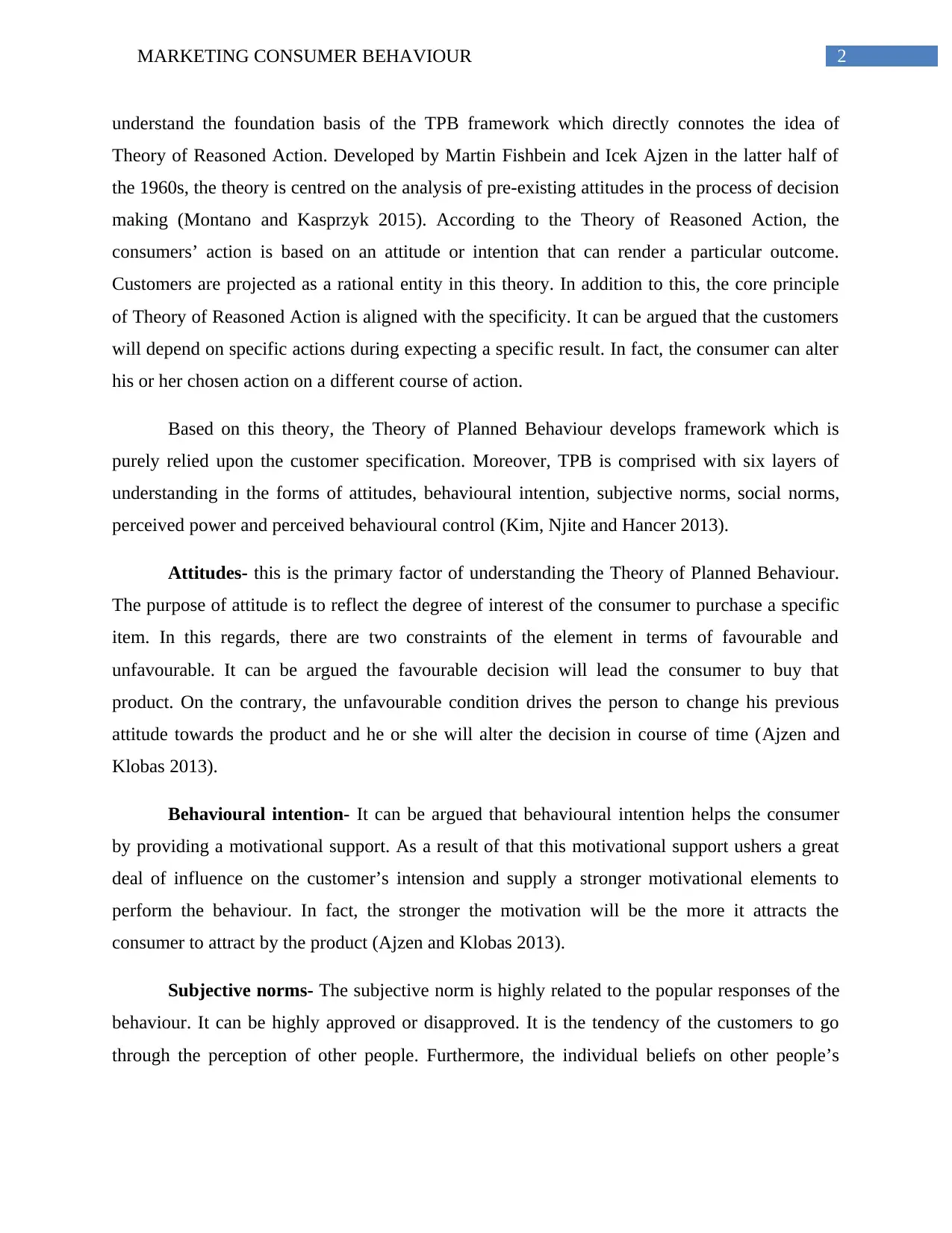
2MARKETING CONSUMER BEHAVIOUR
understand the foundation basis of the TPB framework which directly connotes the idea of
Theory of Reasoned Action. Developed by Martin Fishbein and Icek Ajzen in the latter half of
the 1960s, the theory is centred on the analysis of pre-existing attitudes in the process of decision
making (Montano and Kasprzyk 2015). According to the Theory of Reasoned Action, the
consumers’ action is based on an attitude or intention that can render a particular outcome.
Customers are projected as a rational entity in this theory. In addition to this, the core principle
of Theory of Reasoned Action is aligned with the specificity. It can be argued that the customers
will depend on specific actions during expecting a specific result. In fact, the consumer can alter
his or her chosen action on a different course of action.
Based on this theory, the Theory of Planned Behaviour develops framework which is
purely relied upon the customer specification. Moreover, TPB is comprised with six layers of
understanding in the forms of attitudes, behavioural intention, subjective norms, social norms,
perceived power and perceived behavioural control (Kim, Njite and Hancer 2013).
Attitudes- this is the primary factor of understanding the Theory of Planned Behaviour.
The purpose of attitude is to reflect the degree of interest of the consumer to purchase a specific
item. In this regards, there are two constraints of the element in terms of favourable and
unfavourable. It can be argued the favourable decision will lead the consumer to buy that
product. On the contrary, the unfavourable condition drives the person to change his previous
attitude towards the product and he or she will alter the decision in course of time (Ajzen and
Klobas 2013).
Behavioural intention- It can be argued that behavioural intention helps the consumer
by providing a motivational support. As a result of that this motivational support ushers a great
deal of influence on the customer’s intension and supply a stronger motivational elements to
perform the behaviour. In fact, the stronger the motivation will be the more it attracts the
consumer to attract by the product (Ajzen and Klobas 2013).
Subjective norms- The subjective norm is highly related to the popular responses of the
behaviour. It can be highly approved or disapproved. It is the tendency of the customers to go
through the perception of other people. Furthermore, the individual beliefs on other people’s
understand the foundation basis of the TPB framework which directly connotes the idea of
Theory of Reasoned Action. Developed by Martin Fishbein and Icek Ajzen in the latter half of
the 1960s, the theory is centred on the analysis of pre-existing attitudes in the process of decision
making (Montano and Kasprzyk 2015). According to the Theory of Reasoned Action, the
consumers’ action is based on an attitude or intention that can render a particular outcome.
Customers are projected as a rational entity in this theory. In addition to this, the core principle
of Theory of Reasoned Action is aligned with the specificity. It can be argued that the customers
will depend on specific actions during expecting a specific result. In fact, the consumer can alter
his or her chosen action on a different course of action.
Based on this theory, the Theory of Planned Behaviour develops framework which is
purely relied upon the customer specification. Moreover, TPB is comprised with six layers of
understanding in the forms of attitudes, behavioural intention, subjective norms, social norms,
perceived power and perceived behavioural control (Kim, Njite and Hancer 2013).
Attitudes- this is the primary factor of understanding the Theory of Planned Behaviour.
The purpose of attitude is to reflect the degree of interest of the consumer to purchase a specific
item. In this regards, there are two constraints of the element in terms of favourable and
unfavourable. It can be argued the favourable decision will lead the consumer to buy that
product. On the contrary, the unfavourable condition drives the person to change his previous
attitude towards the product and he or she will alter the decision in course of time (Ajzen and
Klobas 2013).
Behavioural intention- It can be argued that behavioural intention helps the consumer
by providing a motivational support. As a result of that this motivational support ushers a great
deal of influence on the customer’s intension and supply a stronger motivational elements to
perform the behaviour. In fact, the stronger the motivation will be the more it attracts the
consumer to attract by the product (Ajzen and Klobas 2013).
Subjective norms- The subjective norm is highly related to the popular responses of the
behaviour. It can be highly approved or disapproved. It is the tendency of the customers to go
through the perception of other people. Furthermore, the individual beliefs on other people’s
⊘ This is a preview!⊘
Do you want full access?
Subscribe today to unlock all pages.

Trusted by 1+ million students worldwide
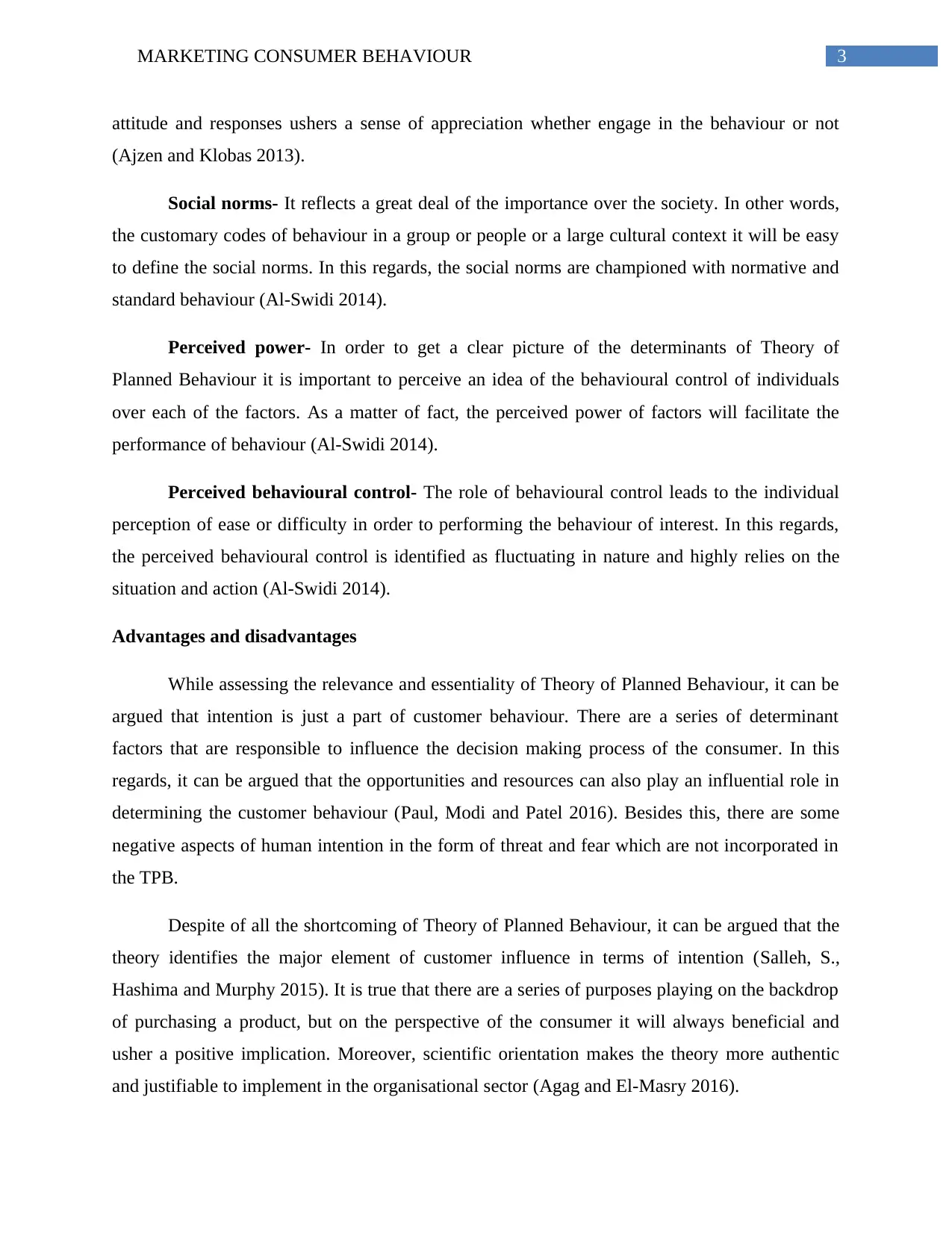
3MARKETING CONSUMER BEHAVIOUR
attitude and responses ushers a sense of appreciation whether engage in the behaviour or not
(Ajzen and Klobas 2013).
Social norms- It reflects a great deal of the importance over the society. In other words,
the customary codes of behaviour in a group or people or a large cultural context it will be easy
to define the social norms. In this regards, the social norms are championed with normative and
standard behaviour (Al-Swidi 2014).
Perceived power- In order to get a clear picture of the determinants of Theory of
Planned Behaviour it is important to perceive an idea of the behavioural control of individuals
over each of the factors. As a matter of fact, the perceived power of factors will facilitate the
performance of behaviour (Al-Swidi 2014).
Perceived behavioural control- The role of behavioural control leads to the individual
perception of ease or difficulty in order to performing the behaviour of interest. In this regards,
the perceived behavioural control is identified as fluctuating in nature and highly relies on the
situation and action (Al-Swidi 2014).
Advantages and disadvantages
While assessing the relevance and essentiality of Theory of Planned Behaviour, it can be
argued that intention is just a part of customer behaviour. There are a series of determinant
factors that are responsible to influence the decision making process of the consumer. In this
regards, it can be argued that the opportunities and resources can also play an influential role in
determining the customer behaviour (Paul, Modi and Patel 2016). Besides this, there are some
negative aspects of human intention in the form of threat and fear which are not incorporated in
the TPB.
Despite of all the shortcoming of Theory of Planned Behaviour, it can be argued that the
theory identifies the major element of customer influence in terms of intention (Salleh, S.,
Hashima and Murphy 2015). It is true that there are a series of purposes playing on the backdrop
of purchasing a product, but on the perspective of the consumer it will always beneficial and
usher a positive implication. Moreover, scientific orientation makes the theory more authentic
and justifiable to implement in the organisational sector (Agag and El-Masry 2016).
attitude and responses ushers a sense of appreciation whether engage in the behaviour or not
(Ajzen and Klobas 2013).
Social norms- It reflects a great deal of the importance over the society. In other words,
the customary codes of behaviour in a group or people or a large cultural context it will be easy
to define the social norms. In this regards, the social norms are championed with normative and
standard behaviour (Al-Swidi 2014).
Perceived power- In order to get a clear picture of the determinants of Theory of
Planned Behaviour it is important to perceive an idea of the behavioural control of individuals
over each of the factors. As a matter of fact, the perceived power of factors will facilitate the
performance of behaviour (Al-Swidi 2014).
Perceived behavioural control- The role of behavioural control leads to the individual
perception of ease or difficulty in order to performing the behaviour of interest. In this regards,
the perceived behavioural control is identified as fluctuating in nature and highly relies on the
situation and action (Al-Swidi 2014).
Advantages and disadvantages
While assessing the relevance and essentiality of Theory of Planned Behaviour, it can be
argued that intention is just a part of customer behaviour. There are a series of determinant
factors that are responsible to influence the decision making process of the consumer. In this
regards, it can be argued that the opportunities and resources can also play an influential role in
determining the customer behaviour (Paul, Modi and Patel 2016). Besides this, there are some
negative aspects of human intention in the form of threat and fear which are not incorporated in
the TPB.
Despite of all the shortcoming of Theory of Planned Behaviour, it can be argued that the
theory identifies the major element of customer influence in terms of intention (Salleh, S.,
Hashima and Murphy 2015). It is true that there are a series of purposes playing on the backdrop
of purchasing a product, but on the perspective of the consumer it will always beneficial and
usher a positive implication. Moreover, scientific orientation makes the theory more authentic
and justifiable to implement in the organisational sector (Agag and El-Masry 2016).
Paraphrase This Document
Need a fresh take? Get an instant paraphrase of this document with our AI Paraphraser
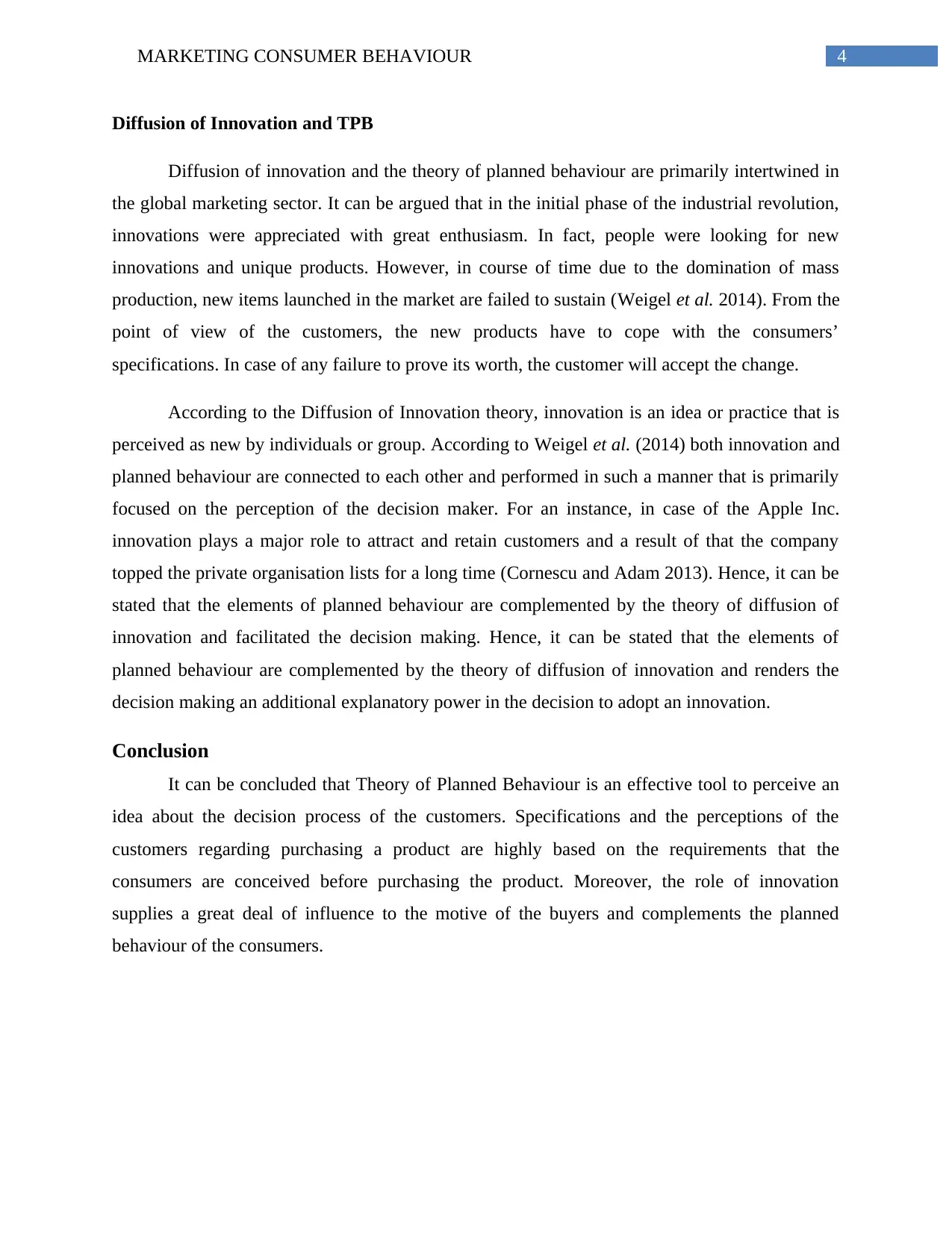
4MARKETING CONSUMER BEHAVIOUR
Diffusion of Innovation and TPB
Diffusion of innovation and the theory of planned behaviour are primarily intertwined in
the global marketing sector. It can be argued that in the initial phase of the industrial revolution,
innovations were appreciated with great enthusiasm. In fact, people were looking for new
innovations and unique products. However, in course of time due to the domination of mass
production, new items launched in the market are failed to sustain (Weigel et al. 2014). From the
point of view of the customers, the new products have to cope with the consumers’
specifications. In case of any failure to prove its worth, the customer will accept the change.
According to the Diffusion of Innovation theory, innovation is an idea or practice that is
perceived as new by individuals or group. According to Weigel et al. (2014) both innovation and
planned behaviour are connected to each other and performed in such a manner that is primarily
focused on the perception of the decision maker. For an instance, in case of the Apple Inc.
innovation plays a major role to attract and retain customers and a result of that the company
topped the private organisation lists for a long time (Cornescu and Adam 2013). Hence, it can be
stated that the elements of planned behaviour are complemented by the theory of diffusion of
innovation and facilitated the decision making. Hence, it can be stated that the elements of
planned behaviour are complemented by the theory of diffusion of innovation and renders the
decision making an additional explanatory power in the decision to adopt an innovation.
Conclusion
It can be concluded that Theory of Planned Behaviour is an effective tool to perceive an
idea about the decision process of the customers. Specifications and the perceptions of the
customers regarding purchasing a product are highly based on the requirements that the
consumers are conceived before purchasing the product. Moreover, the role of innovation
supplies a great deal of influence to the motive of the buyers and complements the planned
behaviour of the consumers.
Diffusion of Innovation and TPB
Diffusion of innovation and the theory of planned behaviour are primarily intertwined in
the global marketing sector. It can be argued that in the initial phase of the industrial revolution,
innovations were appreciated with great enthusiasm. In fact, people were looking for new
innovations and unique products. However, in course of time due to the domination of mass
production, new items launched in the market are failed to sustain (Weigel et al. 2014). From the
point of view of the customers, the new products have to cope with the consumers’
specifications. In case of any failure to prove its worth, the customer will accept the change.
According to the Diffusion of Innovation theory, innovation is an idea or practice that is
perceived as new by individuals or group. According to Weigel et al. (2014) both innovation and
planned behaviour are connected to each other and performed in such a manner that is primarily
focused on the perception of the decision maker. For an instance, in case of the Apple Inc.
innovation plays a major role to attract and retain customers and a result of that the company
topped the private organisation lists for a long time (Cornescu and Adam 2013). Hence, it can be
stated that the elements of planned behaviour are complemented by the theory of diffusion of
innovation and facilitated the decision making. Hence, it can be stated that the elements of
planned behaviour are complemented by the theory of diffusion of innovation and renders the
decision making an additional explanatory power in the decision to adopt an innovation.
Conclusion
It can be concluded that Theory of Planned Behaviour is an effective tool to perceive an
idea about the decision process of the customers. Specifications and the perceptions of the
customers regarding purchasing a product are highly based on the requirements that the
consumers are conceived before purchasing the product. Moreover, the role of innovation
supplies a great deal of influence to the motive of the buyers and complements the planned
behaviour of the consumers.
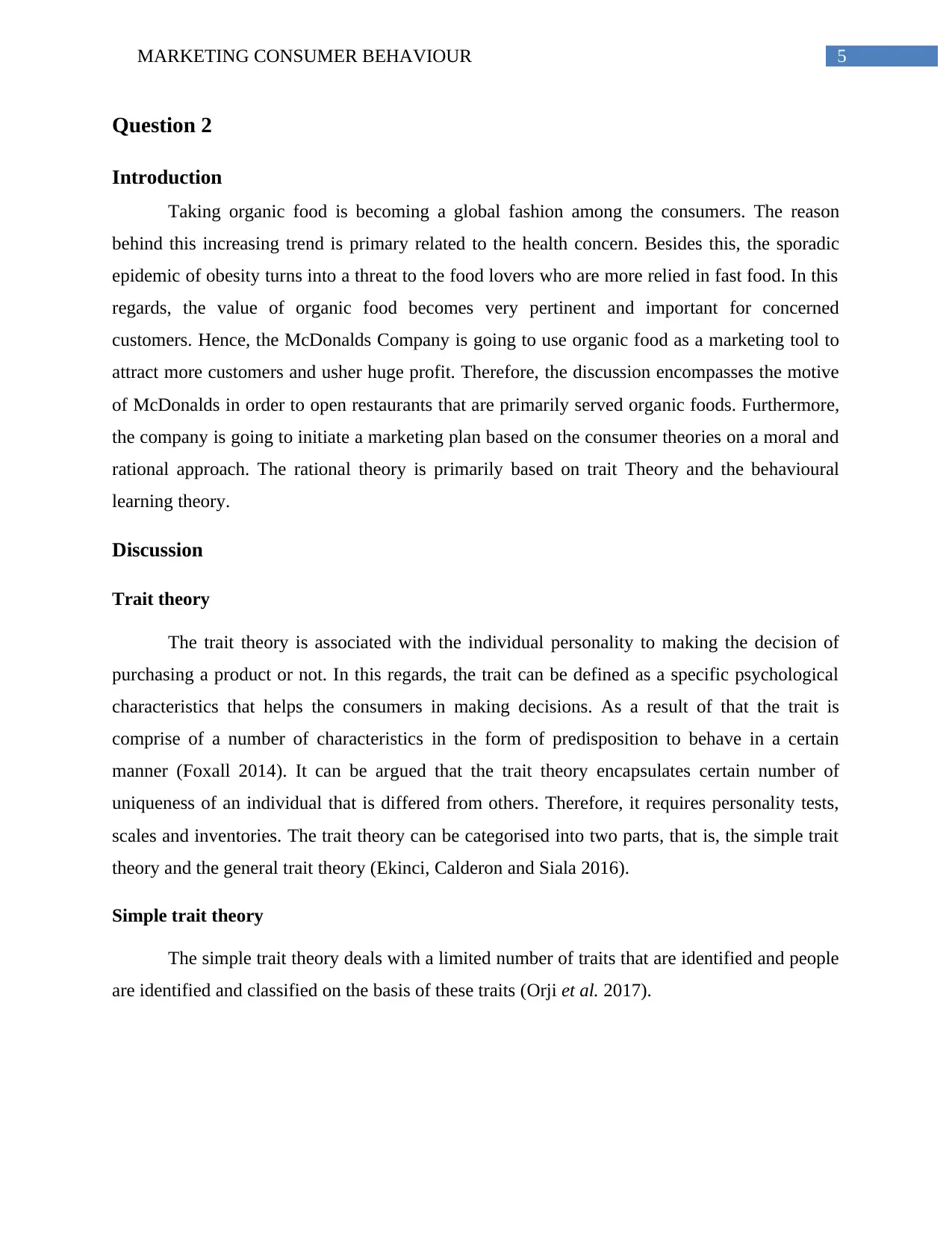
5MARKETING CONSUMER BEHAVIOUR
Question 2
Introduction
Taking organic food is becoming a global fashion among the consumers. The reason
behind this increasing trend is primary related to the health concern. Besides this, the sporadic
epidemic of obesity turns into a threat to the food lovers who are more relied in fast food. In this
regards, the value of organic food becomes very pertinent and important for concerned
customers. Hence, the McDonalds Company is going to use organic food as a marketing tool to
attract more customers and usher huge profit. Therefore, the discussion encompasses the motive
of McDonalds in order to open restaurants that are primarily served organic foods. Furthermore,
the company is going to initiate a marketing plan based on the consumer theories on a moral and
rational approach. The rational theory is primarily based on trait Theory and the behavioural
learning theory.
Discussion
Trait theory
The trait theory is associated with the individual personality to making the decision of
purchasing a product or not. In this regards, the trait can be defined as a specific psychological
characteristics that helps the consumers in making decisions. As a result of that the trait is
comprise of a number of characteristics in the form of predisposition to behave in a certain
manner (Foxall 2014). It can be argued that the trait theory encapsulates certain number of
uniqueness of an individual that is differed from others. Therefore, it requires personality tests,
scales and inventories. The trait theory can be categorised into two parts, that is, the simple trait
theory and the general trait theory (Ekinci, Calderon and Siala 2016).
Simple trait theory
The simple trait theory deals with a limited number of traits that are identified and people
are identified and classified on the basis of these traits (Orji et al. 2017).
Question 2
Introduction
Taking organic food is becoming a global fashion among the consumers. The reason
behind this increasing trend is primary related to the health concern. Besides this, the sporadic
epidemic of obesity turns into a threat to the food lovers who are more relied in fast food. In this
regards, the value of organic food becomes very pertinent and important for concerned
customers. Hence, the McDonalds Company is going to use organic food as a marketing tool to
attract more customers and usher huge profit. Therefore, the discussion encompasses the motive
of McDonalds in order to open restaurants that are primarily served organic foods. Furthermore,
the company is going to initiate a marketing plan based on the consumer theories on a moral and
rational approach. The rational theory is primarily based on trait Theory and the behavioural
learning theory.
Discussion
Trait theory
The trait theory is associated with the individual personality to making the decision of
purchasing a product or not. In this regards, the trait can be defined as a specific psychological
characteristics that helps the consumers in making decisions. As a result of that the trait is
comprise of a number of characteristics in the form of predisposition to behave in a certain
manner (Foxall 2014). It can be argued that the trait theory encapsulates certain number of
uniqueness of an individual that is differed from others. Therefore, it requires personality tests,
scales and inventories. The trait theory can be categorised into two parts, that is, the simple trait
theory and the general trait theory (Ekinci, Calderon and Siala 2016).
Simple trait theory
The simple trait theory deals with a limited number of traits that are identified and people
are identified and classified on the basis of these traits (Orji et al. 2017).
⊘ This is a preview!⊘
Do you want full access?
Subscribe today to unlock all pages.

Trusted by 1+ million students worldwide
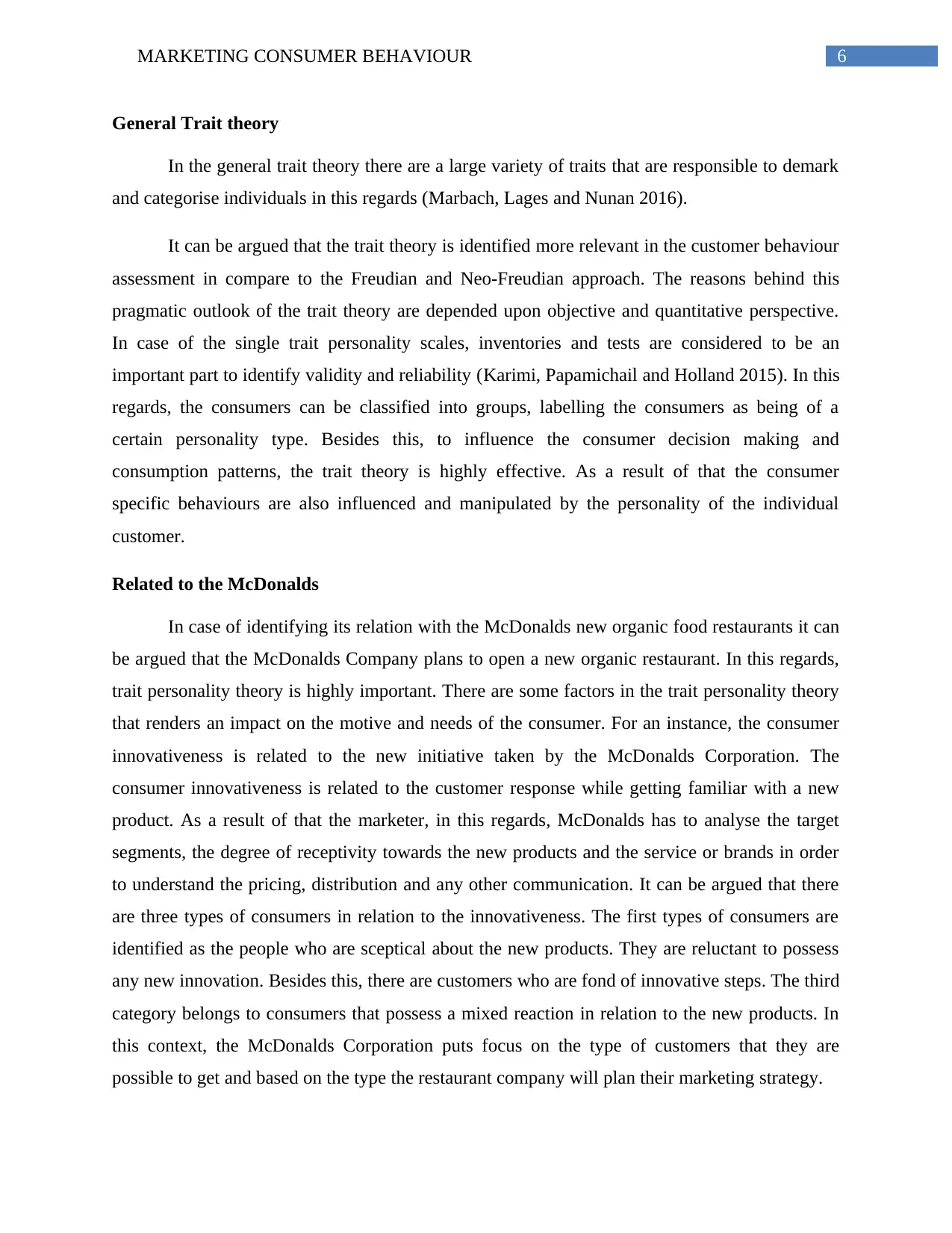
6MARKETING CONSUMER BEHAVIOUR
General Trait theory
In the general trait theory there are a large variety of traits that are responsible to demark
and categorise individuals in this regards (Marbach, Lages and Nunan 2016).
It can be argued that the trait theory is identified more relevant in the customer behaviour
assessment in compare to the Freudian and Neo-Freudian approach. The reasons behind this
pragmatic outlook of the trait theory are depended upon objective and quantitative perspective.
In case of the single trait personality scales, inventories and tests are considered to be an
important part to identify validity and reliability (Karimi, Papamichail and Holland 2015). In this
regards, the consumers can be classified into groups, labelling the consumers as being of a
certain personality type. Besides this, to influence the consumer decision making and
consumption patterns, the trait theory is highly effective. As a result of that the consumer
specific behaviours are also influenced and manipulated by the personality of the individual
customer.
Related to the McDonalds
In case of identifying its relation with the McDonalds new organic food restaurants it can
be argued that the McDonalds Company plans to open a new organic restaurant. In this regards,
trait personality theory is highly important. There are some factors in the trait personality theory
that renders an impact on the motive and needs of the consumer. For an instance, the consumer
innovativeness is related to the new initiative taken by the McDonalds Corporation. The
consumer innovativeness is related to the customer response while getting familiar with a new
product. As a result of that the marketer, in this regards, McDonalds has to analyse the target
segments, the degree of receptivity towards the new products and the service or brands in order
to understand the pricing, distribution and any other communication. It can be argued that there
are three types of consumers in relation to the innovativeness. The first types of consumers are
identified as the people who are sceptical about the new products. They are reluctant to possess
any new innovation. Besides this, there are customers who are fond of innovative steps. The third
category belongs to consumers that possess a mixed reaction in relation to the new products. In
this context, the McDonalds Corporation puts focus on the type of customers that they are
possible to get and based on the type the restaurant company will plan their marketing strategy.
General Trait theory
In the general trait theory there are a large variety of traits that are responsible to demark
and categorise individuals in this regards (Marbach, Lages and Nunan 2016).
It can be argued that the trait theory is identified more relevant in the customer behaviour
assessment in compare to the Freudian and Neo-Freudian approach. The reasons behind this
pragmatic outlook of the trait theory are depended upon objective and quantitative perspective.
In case of the single trait personality scales, inventories and tests are considered to be an
important part to identify validity and reliability (Karimi, Papamichail and Holland 2015). In this
regards, the consumers can be classified into groups, labelling the consumers as being of a
certain personality type. Besides this, to influence the consumer decision making and
consumption patterns, the trait theory is highly effective. As a result of that the consumer
specific behaviours are also influenced and manipulated by the personality of the individual
customer.
Related to the McDonalds
In case of identifying its relation with the McDonalds new organic food restaurants it can
be argued that the McDonalds Company plans to open a new organic restaurant. In this regards,
trait personality theory is highly important. There are some factors in the trait personality theory
that renders an impact on the motive and needs of the consumer. For an instance, the consumer
innovativeness is related to the new initiative taken by the McDonalds Corporation. The
consumer innovativeness is related to the customer response while getting familiar with a new
product. As a result of that the marketer, in this regards, McDonalds has to analyse the target
segments, the degree of receptivity towards the new products and the service or brands in order
to understand the pricing, distribution and any other communication. It can be argued that there
are three types of consumers in relation to the innovativeness. The first types of consumers are
identified as the people who are sceptical about the new products. They are reluctant to possess
any new innovation. Besides this, there are customers who are fond of innovative steps. The third
category belongs to consumers that possess a mixed reaction in relation to the new products. In
this context, the McDonalds Corporation puts focus on the type of customers that they are
possible to get and based on the type the restaurant company will plan their marketing strategy.
Paraphrase This Document
Need a fresh take? Get an instant paraphrase of this document with our AI Paraphraser
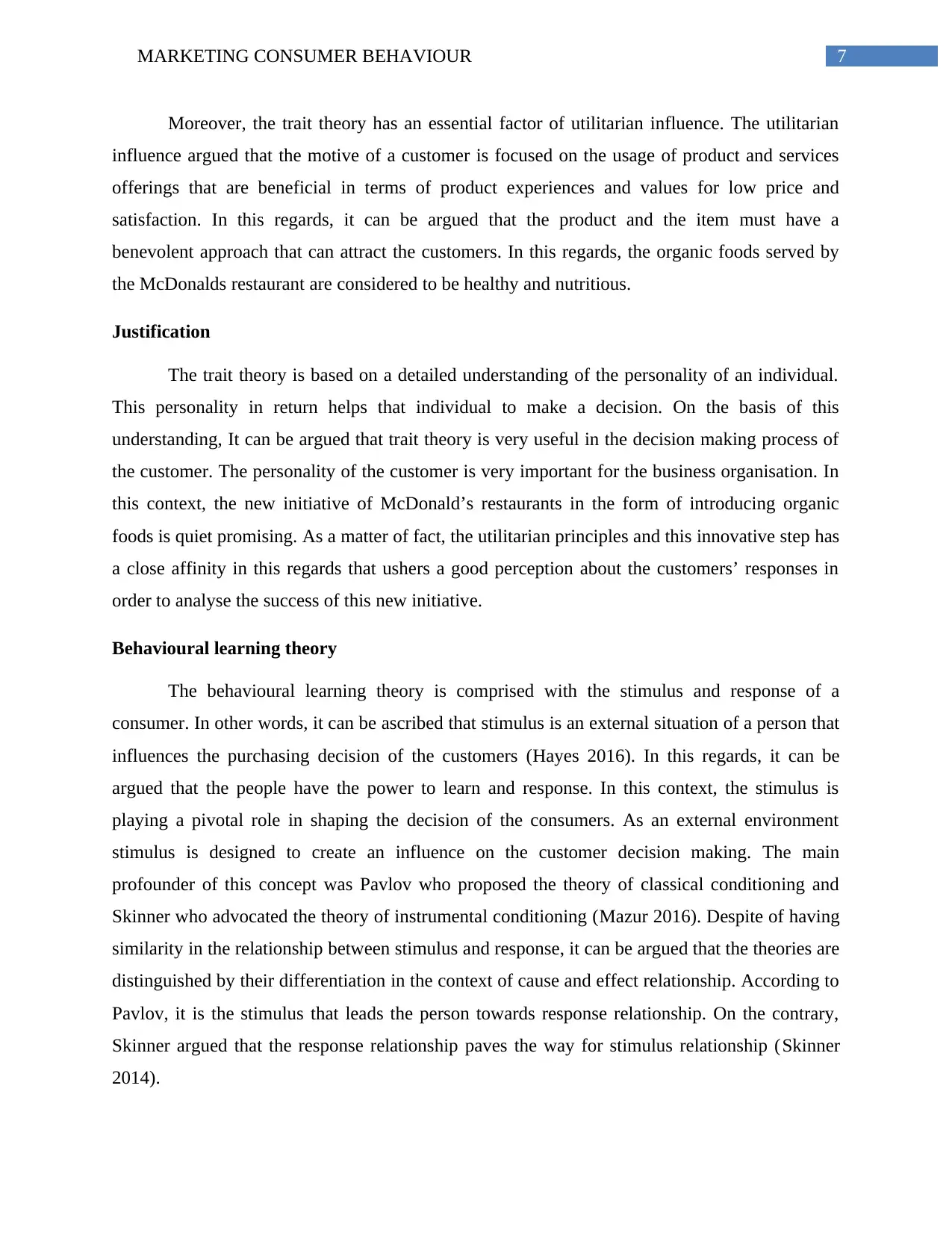
7MARKETING CONSUMER BEHAVIOUR
Moreover, the trait theory has an essential factor of utilitarian influence. The utilitarian
influence argued that the motive of a customer is focused on the usage of product and services
offerings that are beneficial in terms of product experiences and values for low price and
satisfaction. In this regards, it can be argued that the product and the item must have a
benevolent approach that can attract the customers. In this regards, the organic foods served by
the McDonalds restaurant are considered to be healthy and nutritious.
Justification
The trait theory is based on a detailed understanding of the personality of an individual.
This personality in return helps that individual to make a decision. On the basis of this
understanding, It can be argued that trait theory is very useful in the decision making process of
the customer. The personality of the customer is very important for the business organisation. In
this context, the new initiative of McDonald’s restaurants in the form of introducing organic
foods is quiet promising. As a matter of fact, the utilitarian principles and this innovative step has
a close affinity in this regards that ushers a good perception about the customers’ responses in
order to analyse the success of this new initiative.
Behavioural learning theory
The behavioural learning theory is comprised with the stimulus and response of a
consumer. In other words, it can be ascribed that stimulus is an external situation of a person that
influences the purchasing decision of the customers (Hayes 2016). In this regards, it can be
argued that the people have the power to learn and response. In this context, the stimulus is
playing a pivotal role in shaping the decision of the consumers. As an external environment
stimulus is designed to create an influence on the customer decision making. The main
profounder of this concept was Pavlov who proposed the theory of classical conditioning and
Skinner who advocated the theory of instrumental conditioning (Mazur 2016). Despite of having
similarity in the relationship between stimulus and response, it can be argued that the theories are
distinguished by their differentiation in the context of cause and effect relationship. According to
Pavlov, it is the stimulus that leads the person towards response relationship. On the contrary,
Skinner argued that the response relationship paves the way for stimulus relationship (Skinner
2014).
Moreover, the trait theory has an essential factor of utilitarian influence. The utilitarian
influence argued that the motive of a customer is focused on the usage of product and services
offerings that are beneficial in terms of product experiences and values for low price and
satisfaction. In this regards, it can be argued that the product and the item must have a
benevolent approach that can attract the customers. In this regards, the organic foods served by
the McDonalds restaurant are considered to be healthy and nutritious.
Justification
The trait theory is based on a detailed understanding of the personality of an individual.
This personality in return helps that individual to make a decision. On the basis of this
understanding, It can be argued that trait theory is very useful in the decision making process of
the customer. The personality of the customer is very important for the business organisation. In
this context, the new initiative of McDonald’s restaurants in the form of introducing organic
foods is quiet promising. As a matter of fact, the utilitarian principles and this innovative step has
a close affinity in this regards that ushers a good perception about the customers’ responses in
order to analyse the success of this new initiative.
Behavioural learning theory
The behavioural learning theory is comprised with the stimulus and response of a
consumer. In other words, it can be ascribed that stimulus is an external situation of a person that
influences the purchasing decision of the customers (Hayes 2016). In this regards, it can be
argued that the people have the power to learn and response. In this context, the stimulus is
playing a pivotal role in shaping the decision of the consumers. As an external environment
stimulus is designed to create an influence on the customer decision making. The main
profounder of this concept was Pavlov who proposed the theory of classical conditioning and
Skinner who advocated the theory of instrumental conditioning (Mazur 2016). Despite of having
similarity in the relationship between stimulus and response, it can be argued that the theories are
distinguished by their differentiation in the context of cause and effect relationship. According to
Pavlov, it is the stimulus that leads the person towards response relationship. On the contrary,
Skinner argued that the response relationship paves the way for stimulus relationship (Skinner
2014).
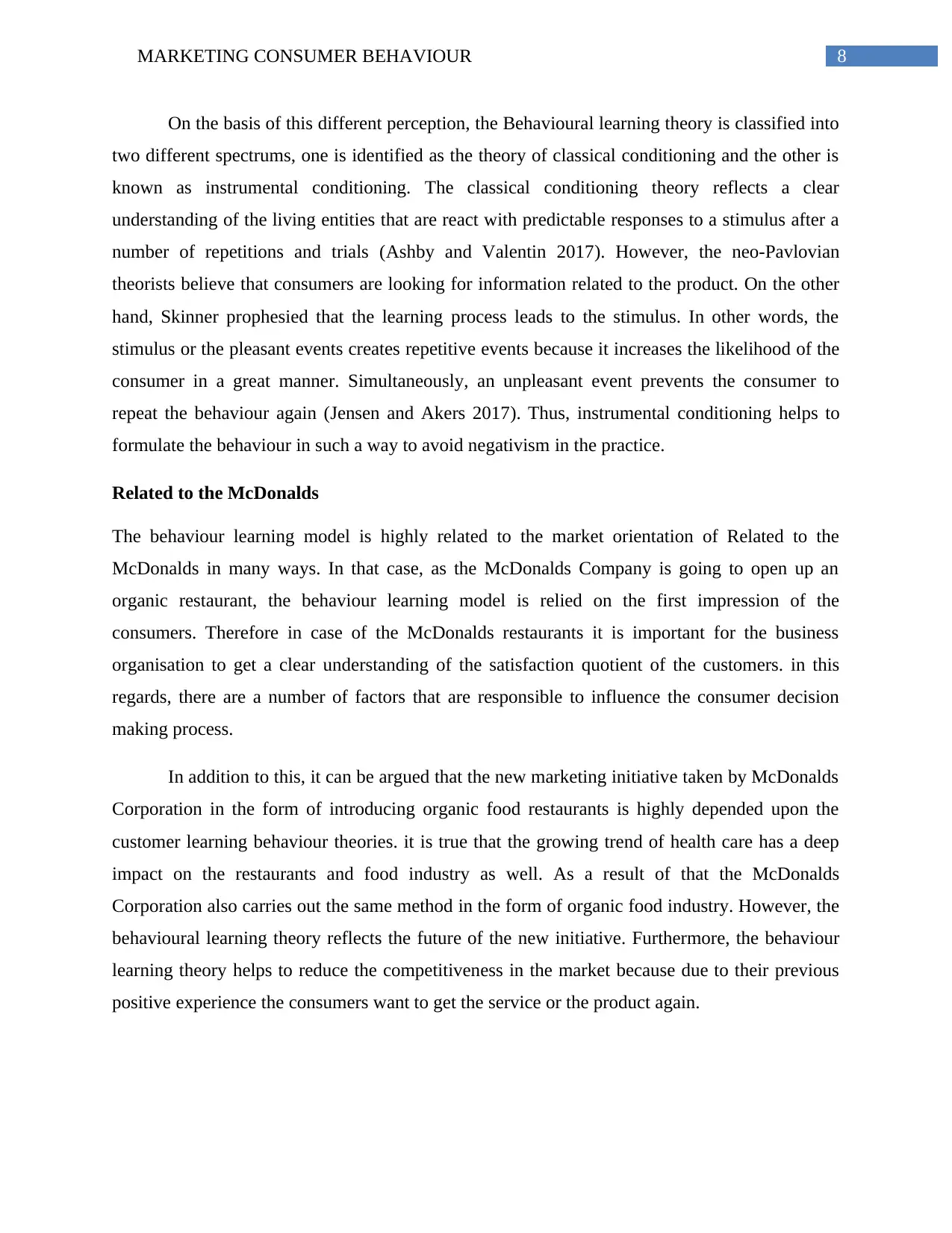
8MARKETING CONSUMER BEHAVIOUR
On the basis of this different perception, the Behavioural learning theory is classified into
two different spectrums, one is identified as the theory of classical conditioning and the other is
known as instrumental conditioning. The classical conditioning theory reflects a clear
understanding of the living entities that are react with predictable responses to a stimulus after a
number of repetitions and trials (Ashby and Valentin 2017). However, the neo-Pavlovian
theorists believe that consumers are looking for information related to the product. On the other
hand, Skinner prophesied that the learning process leads to the stimulus. In other words, the
stimulus or the pleasant events creates repetitive events because it increases the likelihood of the
consumer in a great manner. Simultaneously, an unpleasant event prevents the consumer to
repeat the behaviour again (Jensen and Akers 2017). Thus, instrumental conditioning helps to
formulate the behaviour in such a way to avoid negativism in the practice.
Related to the McDonalds
The behaviour learning model is highly related to the market orientation of Related to the
McDonalds in many ways. In that case, as the McDonalds Company is going to open up an
organic restaurant, the behaviour learning model is relied on the first impression of the
consumers. Therefore in case of the McDonalds restaurants it is important for the business
organisation to get a clear understanding of the satisfaction quotient of the customers. in this
regards, there are a number of factors that are responsible to influence the consumer decision
making process.
In addition to this, it can be argued that the new marketing initiative taken by McDonalds
Corporation in the form of introducing organic food restaurants is highly depended upon the
customer learning behaviour theories. it is true that the growing trend of health care has a deep
impact on the restaurants and food industry as well. As a result of that the McDonalds
Corporation also carries out the same method in the form of organic food industry. However, the
behavioural learning theory reflects the future of the new initiative. Furthermore, the behaviour
learning theory helps to reduce the competitiveness in the market because due to their previous
positive experience the consumers want to get the service or the product again.
On the basis of this different perception, the Behavioural learning theory is classified into
two different spectrums, one is identified as the theory of classical conditioning and the other is
known as instrumental conditioning. The classical conditioning theory reflects a clear
understanding of the living entities that are react with predictable responses to a stimulus after a
number of repetitions and trials (Ashby and Valentin 2017). However, the neo-Pavlovian
theorists believe that consumers are looking for information related to the product. On the other
hand, Skinner prophesied that the learning process leads to the stimulus. In other words, the
stimulus or the pleasant events creates repetitive events because it increases the likelihood of the
consumer in a great manner. Simultaneously, an unpleasant event prevents the consumer to
repeat the behaviour again (Jensen and Akers 2017). Thus, instrumental conditioning helps to
formulate the behaviour in such a way to avoid negativism in the practice.
Related to the McDonalds
The behaviour learning model is highly related to the market orientation of Related to the
McDonalds in many ways. In that case, as the McDonalds Company is going to open up an
organic restaurant, the behaviour learning model is relied on the first impression of the
consumers. Therefore in case of the McDonalds restaurants it is important for the business
organisation to get a clear understanding of the satisfaction quotient of the customers. in this
regards, there are a number of factors that are responsible to influence the consumer decision
making process.
In addition to this, it can be argued that the new marketing initiative taken by McDonalds
Corporation in the form of introducing organic food restaurants is highly depended upon the
customer learning behaviour theories. it is true that the growing trend of health care has a deep
impact on the restaurants and food industry as well. As a result of that the McDonalds
Corporation also carries out the same method in the form of organic food industry. However, the
behavioural learning theory reflects the future of the new initiative. Furthermore, the behaviour
learning theory helps to reduce the competitiveness in the market because due to their previous
positive experience the consumers want to get the service or the product again.
⊘ This is a preview!⊘
Do you want full access?
Subscribe today to unlock all pages.

Trusted by 1+ million students worldwide
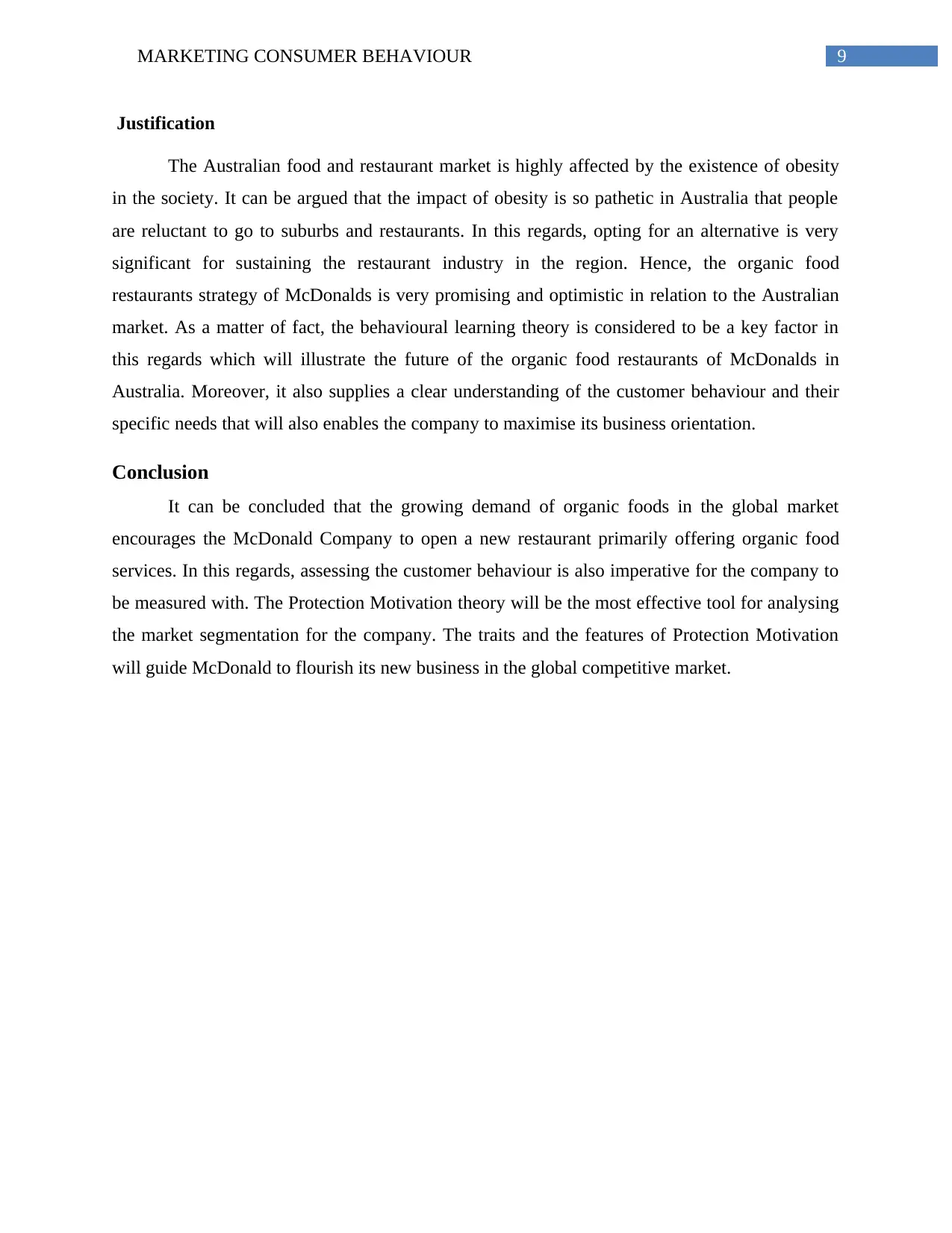
9MARKETING CONSUMER BEHAVIOUR
Justification
The Australian food and restaurant market is highly affected by the existence of obesity
in the society. It can be argued that the impact of obesity is so pathetic in Australia that people
are reluctant to go to suburbs and restaurants. In this regards, opting for an alternative is very
significant for sustaining the restaurant industry in the region. Hence, the organic food
restaurants strategy of McDonalds is very promising and optimistic in relation to the Australian
market. As a matter of fact, the behavioural learning theory is considered to be a key factor in
this regards which will illustrate the future of the organic food restaurants of McDonalds in
Australia. Moreover, it also supplies a clear understanding of the customer behaviour and their
specific needs that will also enables the company to maximise its business orientation.
Conclusion
It can be concluded that the growing demand of organic foods in the global market
encourages the McDonald Company to open a new restaurant primarily offering organic food
services. In this regards, assessing the customer behaviour is also imperative for the company to
be measured with. The Protection Motivation theory will be the most effective tool for analysing
the market segmentation for the company. The traits and the features of Protection Motivation
will guide McDonald to flourish its new business in the global competitive market.
Justification
The Australian food and restaurant market is highly affected by the existence of obesity
in the society. It can be argued that the impact of obesity is so pathetic in Australia that people
are reluctant to go to suburbs and restaurants. In this regards, opting for an alternative is very
significant for sustaining the restaurant industry in the region. Hence, the organic food
restaurants strategy of McDonalds is very promising and optimistic in relation to the Australian
market. As a matter of fact, the behavioural learning theory is considered to be a key factor in
this regards which will illustrate the future of the organic food restaurants of McDonalds in
Australia. Moreover, it also supplies a clear understanding of the customer behaviour and their
specific needs that will also enables the company to maximise its business orientation.
Conclusion
It can be concluded that the growing demand of organic foods in the global market
encourages the McDonald Company to open a new restaurant primarily offering organic food
services. In this regards, assessing the customer behaviour is also imperative for the company to
be measured with. The Protection Motivation theory will be the most effective tool for analysing
the market segmentation for the company. The traits and the features of Protection Motivation
will guide McDonald to flourish its new business in the global competitive market.
Paraphrase This Document
Need a fresh take? Get an instant paraphrase of this document with our AI Paraphraser
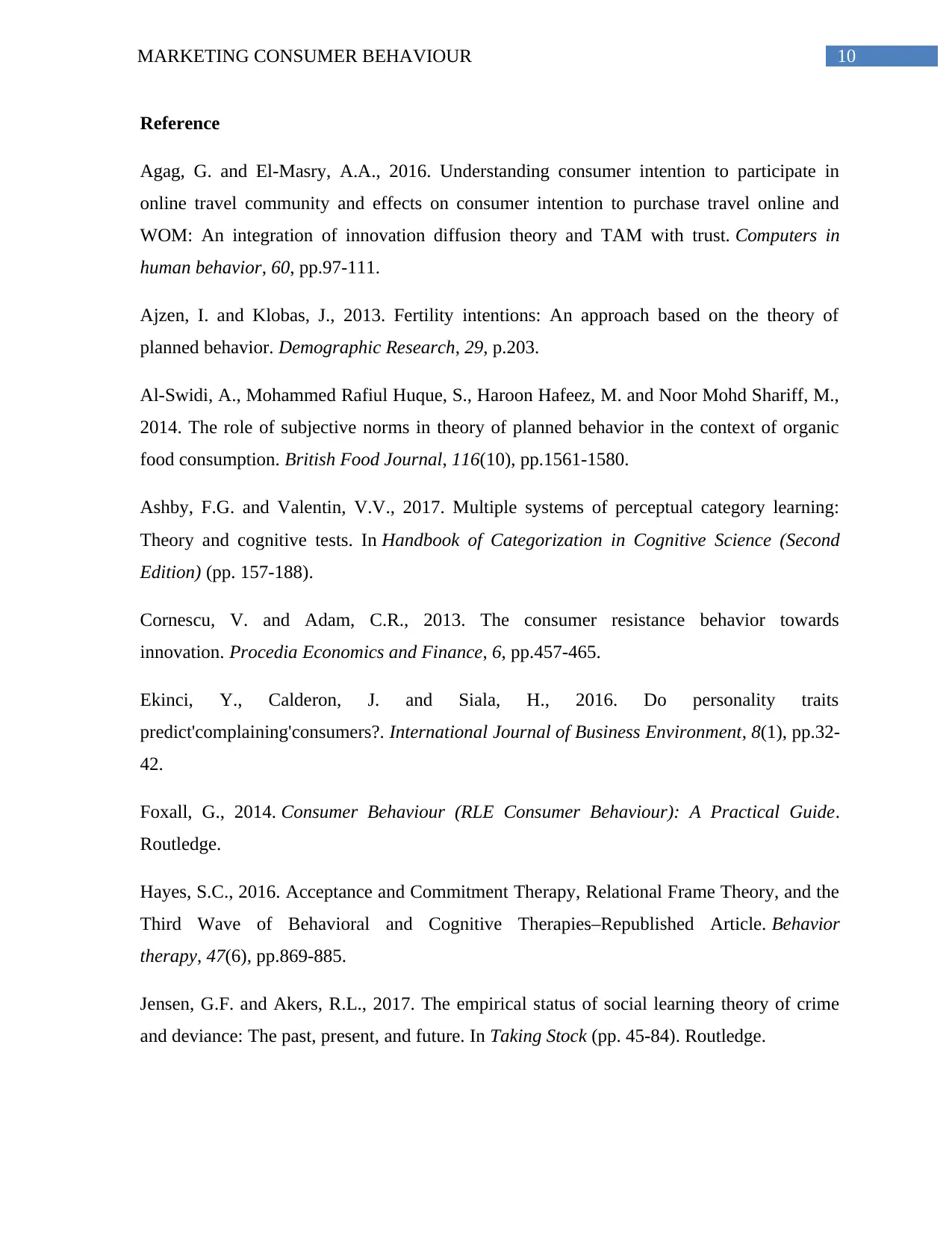
10MARKETING CONSUMER BEHAVIOUR
Reference
Agag, G. and El-Masry, A.A., 2016. Understanding consumer intention to participate in
online travel community and effects on consumer intention to purchase travel online and
WOM: An integration of innovation diffusion theory and TAM with trust. Computers in
human behavior, 60, pp.97-111.
Ajzen, I. and Klobas, J., 2013. Fertility intentions: An approach based on the theory of
planned behavior. Demographic Research, 29, p.203.
Al-Swidi, A., Mohammed Rafiul Huque, S., Haroon Hafeez, M. and Noor Mohd Shariff, M.,
2014. The role of subjective norms in theory of planned behavior in the context of organic
food consumption. British Food Journal, 116(10), pp.1561-1580.
Ashby, F.G. and Valentin, V.V., 2017. Multiple systems of perceptual category learning:
Theory and cognitive tests. In Handbook of Categorization in Cognitive Science (Second
Edition) (pp. 157-188).
Cornescu, V. and Adam, C.R., 2013. The consumer resistance behavior towards
innovation. Procedia Economics and Finance, 6, pp.457-465.
Ekinci, Y., Calderon, J. and Siala, H., 2016. Do personality traits
predict'complaining'consumers?. International Journal of Business Environment, 8(1), pp.32-
42.
Foxall, G., 2014. Consumer Behaviour (RLE Consumer Behaviour): A Practical Guide.
Routledge.
Hayes, S.C., 2016. Acceptance and Commitment Therapy, Relational Frame Theory, and the
Third Wave of Behavioral and Cognitive Therapies–Republished Article. Behavior
therapy, 47(6), pp.869-885.
Jensen, G.F. and Akers, R.L., 2017. The empirical status of social learning theory of crime
and deviance: The past, present, and future. In Taking Stock (pp. 45-84). Routledge.
Reference
Agag, G. and El-Masry, A.A., 2016. Understanding consumer intention to participate in
online travel community and effects on consumer intention to purchase travel online and
WOM: An integration of innovation diffusion theory and TAM with trust. Computers in
human behavior, 60, pp.97-111.
Ajzen, I. and Klobas, J., 2013. Fertility intentions: An approach based on the theory of
planned behavior. Demographic Research, 29, p.203.
Al-Swidi, A., Mohammed Rafiul Huque, S., Haroon Hafeez, M. and Noor Mohd Shariff, M.,
2014. The role of subjective norms in theory of planned behavior in the context of organic
food consumption. British Food Journal, 116(10), pp.1561-1580.
Ashby, F.G. and Valentin, V.V., 2017. Multiple systems of perceptual category learning:
Theory and cognitive tests. In Handbook of Categorization in Cognitive Science (Second
Edition) (pp. 157-188).
Cornescu, V. and Adam, C.R., 2013. The consumer resistance behavior towards
innovation. Procedia Economics and Finance, 6, pp.457-465.
Ekinci, Y., Calderon, J. and Siala, H., 2016. Do personality traits
predict'complaining'consumers?. International Journal of Business Environment, 8(1), pp.32-
42.
Foxall, G., 2014. Consumer Behaviour (RLE Consumer Behaviour): A Practical Guide.
Routledge.
Hayes, S.C., 2016. Acceptance and Commitment Therapy, Relational Frame Theory, and the
Third Wave of Behavioral and Cognitive Therapies–Republished Article. Behavior
therapy, 47(6), pp.869-885.
Jensen, G.F. and Akers, R.L., 2017. The empirical status of social learning theory of crime
and deviance: The past, present, and future. In Taking Stock (pp. 45-84). Routledge.
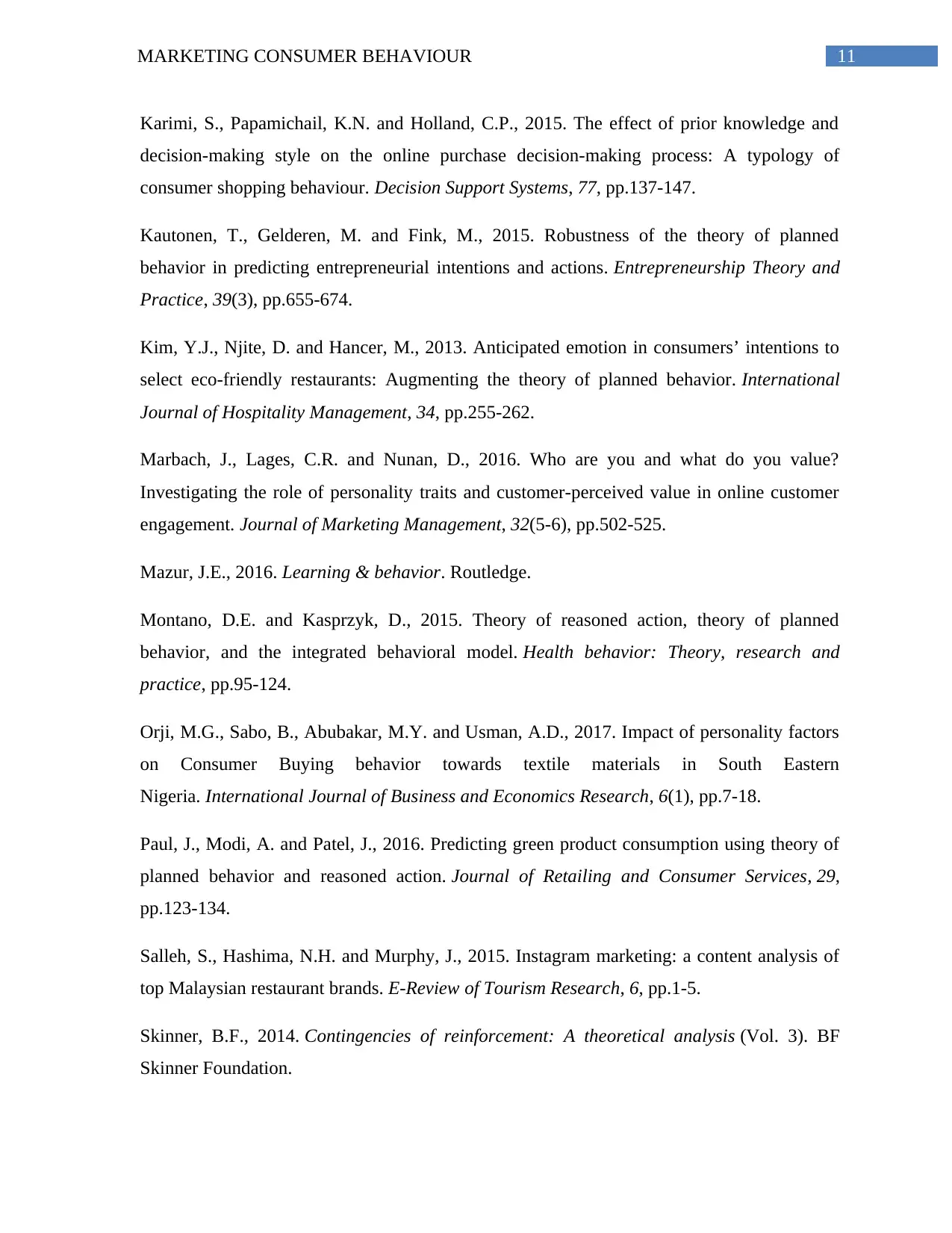
11MARKETING CONSUMER BEHAVIOUR
Karimi, S., Papamichail, K.N. and Holland, C.P., 2015. The effect of prior knowledge and
decision-making style on the online purchase decision-making process: A typology of
consumer shopping behaviour. Decision Support Systems, 77, pp.137-147.
Kautonen, T., Gelderen, M. and Fink, M., 2015. Robustness of the theory of planned
behavior in predicting entrepreneurial intentions and actions. Entrepreneurship Theory and
Practice, 39(3), pp.655-674.
Kim, Y.J., Njite, D. and Hancer, M., 2013. Anticipated emotion in consumers’ intentions to
select eco-friendly restaurants: Augmenting the theory of planned behavior. International
Journal of Hospitality Management, 34, pp.255-262.
Marbach, J., Lages, C.R. and Nunan, D., 2016. Who are you and what do you value?
Investigating the role of personality traits and customer-perceived value in online customer
engagement. Journal of Marketing Management, 32(5-6), pp.502-525.
Mazur, J.E., 2016. Learning & behavior. Routledge.
Montano, D.E. and Kasprzyk, D., 2015. Theory of reasoned action, theory of planned
behavior, and the integrated behavioral model. Health behavior: Theory, research and
practice, pp.95-124.
Orji, M.G., Sabo, B., Abubakar, M.Y. and Usman, A.D., 2017. Impact of personality factors
on Consumer Buying behavior towards textile materials in South Eastern
Nigeria. International Journal of Business and Economics Research, 6(1), pp.7-18.
Paul, J., Modi, A. and Patel, J., 2016. Predicting green product consumption using theory of
planned behavior and reasoned action. Journal of Retailing and Consumer Services, 29,
pp.123-134.
Salleh, S., Hashima, N.H. and Murphy, J., 2015. Instagram marketing: a content analysis of
top Malaysian restaurant brands. E-Review of Tourism Research, 6, pp.1-5.
Skinner, B.F., 2014. Contingencies of reinforcement: A theoretical analysis (Vol. 3). BF
Skinner Foundation.
Karimi, S., Papamichail, K.N. and Holland, C.P., 2015. The effect of prior knowledge and
decision-making style on the online purchase decision-making process: A typology of
consumer shopping behaviour. Decision Support Systems, 77, pp.137-147.
Kautonen, T., Gelderen, M. and Fink, M., 2015. Robustness of the theory of planned
behavior in predicting entrepreneurial intentions and actions. Entrepreneurship Theory and
Practice, 39(3), pp.655-674.
Kim, Y.J., Njite, D. and Hancer, M., 2013. Anticipated emotion in consumers’ intentions to
select eco-friendly restaurants: Augmenting the theory of planned behavior. International
Journal of Hospitality Management, 34, pp.255-262.
Marbach, J., Lages, C.R. and Nunan, D., 2016. Who are you and what do you value?
Investigating the role of personality traits and customer-perceived value in online customer
engagement. Journal of Marketing Management, 32(5-6), pp.502-525.
Mazur, J.E., 2016. Learning & behavior. Routledge.
Montano, D.E. and Kasprzyk, D., 2015. Theory of reasoned action, theory of planned
behavior, and the integrated behavioral model. Health behavior: Theory, research and
practice, pp.95-124.
Orji, M.G., Sabo, B., Abubakar, M.Y. and Usman, A.D., 2017. Impact of personality factors
on Consumer Buying behavior towards textile materials in South Eastern
Nigeria. International Journal of Business and Economics Research, 6(1), pp.7-18.
Paul, J., Modi, A. and Patel, J., 2016. Predicting green product consumption using theory of
planned behavior and reasoned action. Journal of Retailing and Consumer Services, 29,
pp.123-134.
Salleh, S., Hashima, N.H. and Murphy, J., 2015. Instagram marketing: a content analysis of
top Malaysian restaurant brands. E-Review of Tourism Research, 6, pp.1-5.
Skinner, B.F., 2014. Contingencies of reinforcement: A theoretical analysis (Vol. 3). BF
Skinner Foundation.
⊘ This is a preview!⊘
Do you want full access?
Subscribe today to unlock all pages.

Trusted by 1+ million students worldwide
1 out of 15
Related Documents
Your All-in-One AI-Powered Toolkit for Academic Success.
+13062052269
info@desklib.com
Available 24*7 on WhatsApp / Email
![[object Object]](/_next/static/media/star-bottom.7253800d.svg)
Unlock your academic potential
Copyright © 2020–2025 A2Z Services. All Rights Reserved. Developed and managed by ZUCOL.





